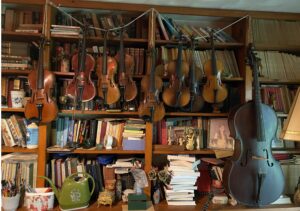Silvia was prepared to toss all the old papers in the attic after her mother passed away. She saw no need to keep multiple boxes filled with ancient, dusty documents, ledgers, postcards, etc. It didn’t occur to her that these “useless scraps” might fetch good money from an antique dealer or ephemera collector. She was stressed and pressed for time, and just wanted to get this job DONE!
Frank admitted that he had too many collections cluttering his home, covering every available surface. Cleaning was impossible; packing it all for a pending move was unimaginable. But he just couldn’t get rid of anything. He was certain all these prized possessions would fetch good money (at least as much as he had paid) when he was ready to sell.
Whether you’re downsizing to reduce stress and clutter, getting ready to move to smaller quarters, or sorting through an estate after a loved one has died, you’ll want to know what’s trash and what’s truly treasure. You don’t want to waste loads of time processing junk, or worse, toss a valuable collectible.
Often we assume family heirlooms are precious collectibles, by virtue of age alone. How could Great-Grandma’s dishes not be worth a fortune? But age alone, or fond memories, does not guarantee significant value. The Limoges china may be beautiful, but if there’s little demand you can forget about a big cash-out.
It’s also common to dismiss an item’s value if you’re unfamiliar or have no personal interest in it. How historically significant is this map? How scarce is this book? Is this style of lamp currently in vogue, featured in every home décor magazine on the rack? Furniture that was once considered tacky and common can become a hot item after being featured in a celebrity’s home. A worn but highly collectible piece can often bring an astonishing price on the resale market after being reupholstered or restored.
The first step in determining what trash is and what’s treasure is to sort items by categories of “Value”.
- Items have resale value if a collector or dealer will pay for money for it.
- Items have decorative value when someone likes it enough to purchase it for their own personal use.
- Some items have value because they can be re-used. Re-use or utility values are typically just a fraction of the original price, if anything at all. Most should be donated.
- Items with nostalgia value are measured better in memories, not dollars. However, these items can sometimes be worth money too.
- Items that no one wants or that have reached the end of their useful lives have NO value!
Values are based on several factors: age, market demand, availability, popularity, geography, condition, provenance, composition, etc. Dealers and wholesales will likely pay 40% or less than what you’d getting when selling an item to an end user.
In most American households, the grand majority of downsized household items have limited or no resale value. Sometimes it’s not even worth the cost or effort to try to sell. If you’re curious, check out the number of eBay listings for an item that you have – if there are thousands, with no bids, that’s an indication of demand. You may spend time listing and tracking your items, incur listing fees, but get nothing in return. An item’s value is worth what someone will pay for it – today.
If you are willing to pay for help, you’ll definitely benefit from a professional’s knowledge of values, market conditions, and how to ultimately dispose of everything from collectibles to junk. Just as you’d hire an attorney or accountant for their specific expertise, make use of an experienced liquidation professional with a rolodex of contacts. S/He can greatly expedite the sorting and valuing process because they know values (or how to determine them) and who’s buying. This will save you considerable time and help you maximize your outcomes– financial and logistical.
Plan on this sorting and valuing process taking some time, from weeks to months, depending on what and who is involved. Consider how much you have (a stuffed room could days or longer). Ask family and friends what they want; this can quickly shrink the pile and leave fewer decisions, but it may take a while for relatives to arrive on the scene and identify their choices. Allot time to take and send photos (essential if you’re requesting help identifying and valuing pieces). Add more time for researching via the internet, phone calls, or having someone see the items in person. Finally, you’ll need to locate and deal with charities, dealers, auction houses, or other venues for disposal.
It’s a lot of work, to say the least. Sorting the trash from the treasure, then liquidating it all, requires a multitude of decisions and a healthy supply of time and labor. Some people embrace the process. Often, though, the task comes at a stressful time, after an illness or loss, or when physical and emotional resources are at a low point. It’s obvious that getting help (wherever you can find it) will make the process much easier and more fruitful.



